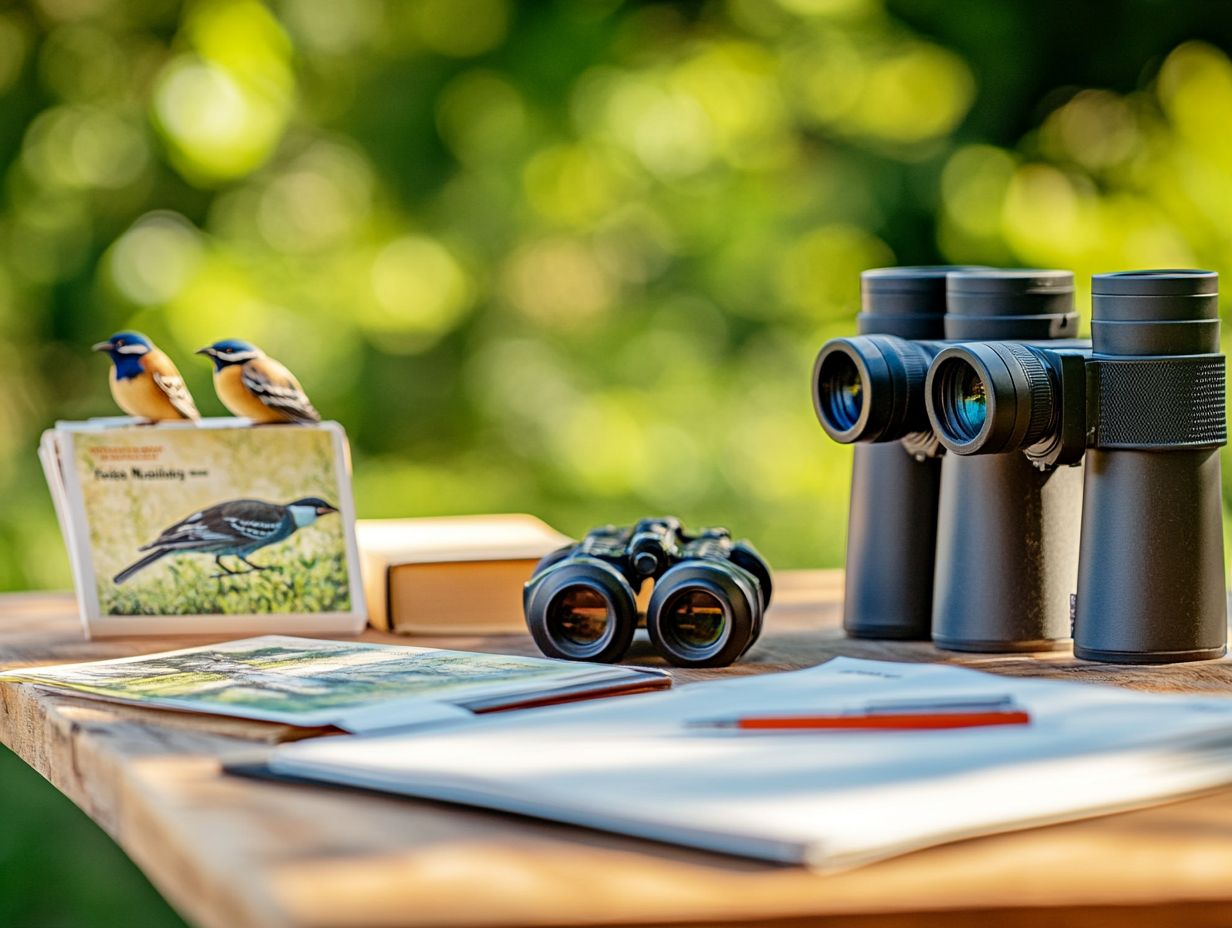Field Guides: Essential Tools for Bird Conservation
Bird conservation is essential for preserving biodiversity and ensuring the vitality of our ecosystems. Protecting these remarkable creatures is crucial. Field guides serve as invaluable allies in this endeavor.
These resources empower you to identify various bird species while fostering awareness and understanding of their habitats. In this exploration, you will discover the different types of field guides available, learn effective strategies for utilizing them, and understand how they significantly contribute to conservation efforts.
Contents
- Key Takeaways:
- The Importance of Bird Conservation
- What is a Field Guide?
- Types of Field Guides
- How to Use a Field Guide
- Choosing the Right Field Guide
- Field Guides for Bird Conservation
- Frequently Asked Questions
- What is a field guide and how is it useful for bird conservation?
- Are all field guides the same?
- Do I need a field guide to identify birds?
- Can a field guide help me learn more about bird behavior and conservation?
- Are field guides only for experienced birders?
- Can I use a digital field guide instead of a physical book?
Key Takeaways:

- Field guides are crucial tools for bird conservation, aiding in the identification and understanding of different bird species and their habitats.
- These guides come in various forms, from traditional print versions to digital options, providing accessibility and convenience for bird enthusiasts.
- By using field guides, individuals can help identify and monitor bird populations and their habitats, promoting the protection and preservation of these species.
The Importance of Bird Conservation
Bird conservation plays a vital role in preserving biodiversity and ensuring ecological balance. Numerous bird species act as indicators of environmental health. Organizations like the National Audubon Society champion the protection of avian habitats and species throughout North America. They underscore the pressing need to confront challenges like habitat loss and climate change.
These initiatives safeguard the birds and enrich local communities and wildlife enthusiasts who deeply value their outdoor experiences.
Why We Need to Protect Birds and Their Habitats
Protecting birds and their habitats is crucial for maintaining biodiversity and ensuring the well-being of local communities. Many communities rely on healthy ecosystems for their outdoor experiences.
Birds fulfill a range of important jobs in nature think pollinators, seed dispersers, and natural pest controllers. All these roles contribute to the overall health and resilience of their environments. Their presence is often a hallmark of a balanced ecosystem. When bird populations decline, it can signal deeper issues that may affect human communities as well.
You can see local communities thrive through activities like birdwatching, tourism, and education. People connect with nature and learn valuable lessons about conservation efforts. Unfortunately, many bird species face significant conservation challenges, with countless populations on the brink of extinction. This highlights why we must act now to protect our birds!
You can be a vital part of habitat restoration initiatives, helping to create sanctuaries where avian species can flourish. Your passionate commitment raises awareness and galvanizes community action, making a profound impact on preserving these essential species and their habitats.
What is a Field Guide?
A field guide is an essential resource designed to enhance your ability to identify and comprehend various species, especially birds, in their natural environments. These guides offer detailed descriptions, vibrant full-color photographs, and insights into the conservation status of different bird species. For more information on their benefits, check out how field guides enhance your bird watching. They are invaluable tools for both newcomers and experienced bird watchers alike.
Crafted with contributions from scientific experts, the content ensures you can navigate taxonomic orders the scientific way we classify living things and other crucial ecological information with accuracy and confidence.
Definition and Purpose
The primary purpose of a field guide is to be your trusted navigation tool. It helps you identify birds while shedding light on their conservation status, highlighting the importance of field guides in bird watching.
These guides go beyond simple identification; they offer essential insights into bird behaviors, habitats, and ecological roles, as outlined in Field Guides: The Art of Birdwatching Simplified.
For anyone passionate about birds, understanding these details enriches your appreciation of local wildlife.
Today, bird watchers can explore innovative navigation tools beyond printed guides. Smartphone apps and digital field guides elevate your experience with features like audio calls and interactive maps.
These advancements connect novice observers with seasoned enthusiasts. They foster a deeper connection with nature and enhance your birding journey.
Types of Field Guides

Field guides come in various forms, tailored to meet the needs of bird watchers and conservationists. You’ll find regional guides like the Peterson Field Guides, which focus on specific geographic areas, as well as resources that explore the role of field guides in conservation efforts.
Species-specific guides explore individual bird species. They offer comprehensive descriptions and stunning photographs.
Digital guides are gaining traction, equipped with interactive tools and instant access to extensive databases, including the most comprehensive bird field guides available. This significantly enhances your birdwatching experience.
Regional, Species-specific, and Digital Guides
There are three primary categories of field guides: regional, species-specific, and digital. Each caters to the diverse needs of birdwatchers.
Regional guides focus on specific geographic areas. They offer invaluable insights into local bird species and their habitats.
Species-specific guides provide detailed illustrations and vocalizations. Renowned organizations like the Cornell Lab of Ornithology exemplify this approach.
Digital guides shine in usability. They include features like interactive maps for real-time information, making birdwatching engaging and accessible.
How to Use a Field Guide
Using a field guide effectively means immersing yourself in identification tips. This will elevate your outdoor experience and help you navigate the diverse world of bird species.
By honing these skills, you’ll gain a deeper appreciation for nature. You’ll connect with the avian wonders around you.
Tips and Techniques for Identification
Effective birdwatching hinges on mastering identification techniques. Utilize full-color photographs and detailed descriptions found in field guides.
Focus on specific color patterns, sizes, and behaviors of various species to enhance your skills. It’s essential to cross-reference observations with field guide content.
Practice these techniques in diverse environments. Whether in an urban park or a serene forest, you’ll deepen your understanding of avian life.
This journey will not only sharpen your skills but also deepen your appreciation for the intricate dynamics of bird behavior.
Choosing the Right Field Guide
Selecting the ideal field guide requires careful consideration of several key factors. Consider the specific geographic region you’re exploring, the types of bird species that interest you, and the conservation status of those species.
Each element plays a vital role in ensuring that your birdwatching experience is enriching and aligned with your passion for avian conservation, which means protecting bird species and their habitats.
Key Considerations for Choosing the Best Field Guide!

When selecting a field guide, reflect on your personal preferences and the unique features offered by popular options available to bird watchers.
You might lean towards a guide with detailed illustrations. Others may prefer photographic representations for straightforward identification. Guides like the National Geographic Field Guide to the Birds of North America are celebrated for their comprehensive distribution maps and expert insights, making them a top choice among serious birders!
On the other hand, the Peterson Field Guide series employs a unique color-coded system that helps novice birdwatchers quickly identify species. The usability of each guide can vary based on portability, size, and the inclusion of regional subsets, all of which can significantly enhance your birdwatching experience based on your needs.
Field Guides for Bird Conservation
Field guides hold a crucial role in bird conservation efforts, serving as essential resources for bird identification. They educate and empower you to actively participate in wildlife protection initiatives, such as those detailed in Field Guides: Navigating the World of Birds.
How Field Guides Support Conservation Efforts
Field guides are vital in supporting conservation efforts by equipping you with essential information about bird species, their conservation status, their habitats, and proactive measures local communities can take to protect them.
Take, for example, the community-driven project Birds of the Valley. It harnessed the power of field guides to teach residents about preserving wetland habitats and understanding mushroom ecology and wildflowers. Workshops used these guides to raise awareness and encourage participation, ultimately forming local birdwatching clubs. This initiative connected you and fellow wildlife enthusiasts with your environment while promoting sustainable practices that protect critical habitats.
As individuals and families became more informed, they took proactive steps in conservation activities. For instance, they utilized tools like the Garmin GPSMAP 66sr for accurate navigation, making a notable impact on local ecosystems and fostering a profound sense of stewardship among community members!
Frequently Asked Questions
What is a field guide and how is it useful for bird conservation?
A field guide is a book or digital resource that contains information about different species of birds, including their physical features, behavior, and habitat. For new enthusiasts, field guides: tips for new bird watchers can be particularly useful. It is also essential for bird conservation because it helps identify and document different species, which is crucial for monitoring and protecting their populations.
Are all field guides the same?

No, field guides can vary in content, format, and level of detail. Some may focus on a specific region or group of birds, while others cover a broader range. It is essential to choose a field guide that aligns with your location and conservation goals!
Do I need a field guide to identify birds?
No, you can also use other resources such as birding apps or online databases. However, a field guide is a reliable and portable tool that allows you to quickly identify birds in the field without relying on technology or internet access.
Get involved in birdwatching or conservation activities today! Every step you take helps protect our feathered friends!
Can a field guide help me learn more about bird behavior and conservation?
Absolutely! Field guides offer detailed insights into bird behavior, breeding habits, and migration patterns. They also feature stunning full-color photographs.
This information can help bird enthusiasts and conservationists better understand and protect these creatures.
Are field guides only for experienced birders?
Not at all! Field guides are perfect for beginners eager to learn about birds and how they re grouped. They make it easy to identify and study various bird species.
Whether you’re just starting or looking to deepen your knowledge, these guides are an invaluable resource.
Can I use a digital field guide instead of a physical book?
Yes! Digital field guides are handy and eco-friendly. You can access them on your smartphone or tablet and may find added features, like bird calls and photos.
Just remember to bring a reliable power source or backup battery when using a digital guide outdoors!






